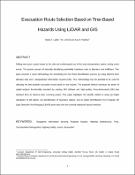Options
Evacuation route selection based on tree-based hazards using LiDar and GIS
Author(s)
Date Issued
2006-04
Date Available
2010-08-05T16:13:50Z
Abstract
Falling trees pose a great hazard to the safe and uninterrupted use of the road transportation system, during storm events. The present process of manually identifying potentially hazardous trees is laborious and inefficient. This paper presents a novel methodology for automating the tree threat identification process by using airborne laser altimetry data and a Geographical Information System (GIS). This methodology has the potential to be used for selecting the best possible evacuation routes based on tree hazards. The proposed method harnesses the power of spatial analysis functionality provided by existing GIS software and high-quality, three-dimensional (3D) data obtained from an airborne laser scanning system. This paper highlights the benefits related to using (a) height calculation of tall objects, (b) identification of hazardous objects, and (c) object identification from irregular 3D Light Detection And Ranging (LiDAR) point data over the currently employed manual methods.
Sponsorship
Other funder
Other Sponsorship
Southeast Transport Centre
Type of Material
Journal Article
Publisher
American Society of Civil Engineering (ASCE)
Journal
Journal of Transportation Engineering
Volume
132
Issue
4
Start Page
312
End Page
320
Copyright (Published Version)
2006 ASCE
Subject – LCSH
Evacuation of civilians
Tree hazard evaluation
Geographic information systems
Optical radar
Traffic engineering
Language
English
Status of Item
Peer reviewed
ISSN
0733-947X
This item is made available under a Creative Commons License
File(s)
Loading...
Name
47..pdf
Size
1.03 MB
Format
Adobe PDF
Checksum (MD5)
f2ebdfe7f9c8d4bddb6b8b1257811703
Owning collection